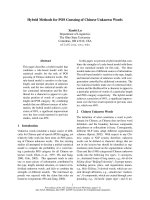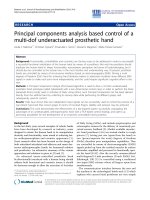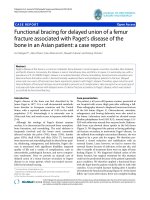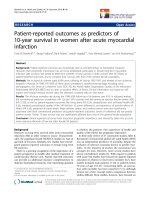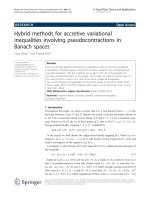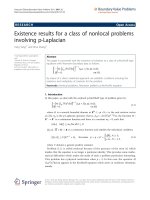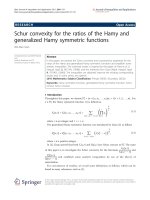báo cáo hóa học:" Efficient methods for joint estimation of multiple fundamental frequencies in music signals" docx
Bạn đang xem bản rút gọn của tài liệu. Xem và tải ngay bản đầy đủ của tài liệu tại đây (2.44 MB, 51 trang )
This Provisional PDF corresponds to the article as it appeared upon acceptance. Fully formatted
PDF and full text (HTML) versions will be made available soon.
Efficient methods for joint estimation of multiple fundamental frequencies in
music signals
EURASIP Journal on Advances in Signal Processing 2012,
2012:27 doi:10.1186/1687-6180-2012-27
Antonio Pertusa ()
Jose M. Inesta ()
ISSN 1687-6180
Article type Research
Submission date 11 April 2011
Acceptance date 14 February 2012
Publication date 14 February 2012
Article URL />This peer-reviewed article was published immediately upon acceptance. It can be downloaded,
printed and distributed freely for any purposes (see copyright notice below).
For information about publishing your research in EURASIP Journal on Advances in Signal
Processing go to
/>For information about other SpringerOpen publications go to
EURASIP Journal on Advances
in Signal Processing
© 2012 Pertusa and Inesta ; licensee Springer.
This is an open access article distributed under the terms of the Creative Commons Attribution License ( />which permits unrestricted use, distribution, and reproduction in any medium, provided the original work is properly cited.
Efficient methods for joint estimation of
multiple fundamental frequencies in music
signals
Antonio Pertusa
∗
and Jos´e M I˜nesta
Departamento de Lenguajes y Sistemas Inform´aticos, Universidad de Alicante,
P.O. Box 99, E-03080 Alicante, Spain
∗
Corresponding author:
Email address:
JMI:
Abstract
This study presents efficient techniques for multiple fundamental frequency
estimation in music signals. The proposed methodology can infer harmonic
patterns from a mixture considering interactions with other sources and evaluate
them in a joint estimation scheme. For this purpose, a set of fundamental
frequency candidates are first selected at each frame, and several hypothetical
combinations of them are generated. Combinations are independently evaluated,
and the most likely is selected taking into account the intensity and spectral
1
smoothness of its inferred patterns. The method is extended considering adjacent
frames in order to smooth the detection in time, and a pitch tracking stage is
finally performed to increase the temporal coherence. The proposed algorithms
were evaluated in MIREX contests yielding state of the art results with a very low
computational burden.
1 Introduction
The goal of a multiple fundamental frequency (f
0
) estimation method is to
infer the number of simultaneous harmonic sounds present in an acoustic
signal and their fundamental frequencies. This problem is relevant in speech
processing, structural audio coding, and several music information retrieval
(MIR) applications, like automatic music transcription, compression,
instrument separation and chord estimation, among others.
In this study, a multiple f
0
estimation method is presented for the analysis of
pitched musical signals. The core methodology introduced in [1] is described
and extended considering information about neighbor frames.
Most multiple f
0
estimation methods are complex systems. The decomposition
of a signal into multiple simultaneous sounds is a challenging task due to
harmonic overlaps and inharmonicity (when partial frequencies are not exact
multiples of the f
0
). Many different techniques are proposed in the literature
to face this task. Recent reviews of multiple f
0
estimation in music signals can
be found in [2–4].
Some techniques rely on the mid-level representation, trying to emphasize the
2
underlying fundamental frequencies by applying signal processing
transformations to the input signal [5–7]. Supervised [8, 9] and
unsupervised [10, 11] learning techniques have also been investigated for this
task. The matching pursuit algorithm, which approximates a solution for
decomposing a signal into linear functions (atoms), is also adopted in some
approaches [12, 13]. Methods based on statistical inference within parametric
signal models [3, 14, 15] have also been studied for this task.
Heuristic approaches can also be found in the literature. Iterative cancellation
methods estimate the prominent f
0
subtracting it from the mixture and
repeating the process until a termination criterion [16–18]. Joint estimation
methods [19–21] can evaluate a set of possible f
0
hypotheses, consisting of f
0
combinations, selecting the most likely at each frame without corrupting the
residual as it occurs with iterative cancellation.
Some existing methods can be switched to another framework. For example,
iterative methods can be viewed against matching pursuit background, and
many unsupervised learning methods like [11] can be switched to a statistical
framework.
Statistical inference provides an elegant framework to deal with this problem,
but these methods are usually intended for single instrument f
0
estimation
(typically piano), as exact inference often becomes computationally intractable
for complex and very different sources.
Similarly, supervised learning methods can infer models of pitch combinations
seen in the training stage, but they are currently constrained to monotimbral
sounds with almost constant spectral profiles [4].
In music, consonant chords include harmonic components of different sounds
which coincide in some of their partial frequencies (harmonic overlaps). This
situation is very frequent and introduces ambiguity in the analysis, being the
main challenge in multiple f
0
estimation. When two harmonics are
3
overlapped, two sinusoids of the same frequency are summed in the waveform,
resulting a signal with the same frequency and which magnitude depends on
their phase difference.
The contribution of each harmonic to the mixture can not be properly
estimated without considering the interactions with the other sources. Joint
estimation methods provide an adequate framework to deal with this problem,
as they do not assume that sources are mutually independent and individual
pitch models can be inferred taking into account their interactions. However,
they tend to have high computational costs due to the number of possible
combinations to be evaluated.
Novel efficient joint estimation techniques are presented in this study. In
contrast to previous joint approaches, the proposed algorithms have a very low
computational cost. They were evaluated and compared to other studies in
MIREX [22, 23] multiple f
0
estimation and tracking contests, yielding
competitive results with very efficient runtimes.
The core process, introduced in [1], relies on the inference and evaluation of
spectral patterns from the mixture. For a proper inference, source interactions
must be considered in order to estimate the amplitudes of their overlapped
harmonics. This is accomplished by evaluating independent combinations
consisting of hypothetical patterns (f
0
candidates). The evaluation criterion
enhances those patterns having high intensity and smoothness. This way, the
method takes advantage of the spectral properties of most harmonic sounds, in
which first harmonics are usually those with higher energy and their spectral
profile tend to be smooth.
Evaluating many possible combinations can computationally intractable. In
this study, the efficiency is boosted by reducing the spectral information to be
considered for the analysis, adding a f
0
candidate selection process, and
pruning unlikely combinations by applying some constraints, like a minimum
4
intensity for a pattern.
One of the main contributions of this study is the extension of the core
algorithm to increase the temporal coherence. Instead considering isolated
frames, the combinations sharing the same pitches across neighbor frames are
grouped to smooth the detection in time. A novel pitch tracking stage is
finally presented to favor smooth transitions of pitch intensities.
The proposed algorithms are publicly available at
http://grfia.dlsi.ua.es/cm/projects/drims/software.php.
The overall scheme of the system can be seen in Figure 1. The core
methodology performing a frame by frame analysis is described in Sec. 2,
whereas the extended method which considers temporal information is
presented in Sec. 3. The evaluation results are described in Sec. 4, and the
conclusions and perspectives are finally discussed in Sec. 5.
2 Methodology
Joint estimation methods generate and evaluate competing sets of f
0
combinations in order to select the most plausible combination directly. This
scheme, recently introduced in [24, 25] has the advantage that the amplitudes
of overlapping partials can be approximated taking into account the partials of
the other candidates for a given combination. Therefore, partial amplitudes
can depend on the particular combination to be evaluated, opposite to an
iterative estimation scheme like matching pursuit, where a wrong estimate
may produce cumulative errors.
The core method performs a frame by frame analysis, selecting the most likely
combination of fundamental frequencies at each instant. For this purpose, a
set of f
0
candidates are first identified from the spectral peaks. Then, a set of
possible combinations, C(t), of candidates are generated, and a joint algorithm
5
is used to find the most likely combination.
In order to evaluate a combination, hypothetical partial sequences HPS (term
proposed in [26] to refer to a vector containing hypothetical partial
amplitudes) are inferred for its candidates. In order to build these patterns,
harmonic interactions with the partials of the other candidates in the
combination are considered. The overlapped partials are first identified, and
their amplitudes are estimated by linear interpolation using the
non-overlapped harmonic amplitudes.
Once patterns are inferred, they are evaluated taking into account the sum of
its hypothetical harmonic amplitudes and a novel smoothness measure.
Combinations are analysed considering their individual candidate scores, and
the most likely combination is selected at the target frame.
The method assumes that the spectral envelopes of the analysed sounds tend
to vary smoothly as a function of frequency. The spectral smoothness principle
has successfully been used in different ways in the literature [7, 26–29]. A novel
smoothness measure based on the convolution of the hypothetical harmonic
pattern with a Gaussian window is proposed.
The processing stages, shown in Figure 1, are described below.
2.1 Preprocessing
The analysis is performed in the frequency domain, computing the magnitude
spectrogram using a 93 ms Hanning windowed frame with a 9.28 ms hop size.
This is the frame size typically chosen for multiple f
0
estimation of music
signals in order to achieve a suitable frequency resolution, and it
experimentally showed to be adequate. The selected frame overlap ratio may
seem high from a practical point of view, but it was required to compare the
method with other studies in MIREX (see 4.3).
6
To get a more precise estimation of the lower frequencies, zero padding is used
multiplying the original window size by a factor z to complete it with zeroes
before computing the FFT.
In order to increase the efficiency, many unnecessary spectral bins are
discarded for the subsequent analysis using a simple peak picking algorithm to
extract the hypothetical partials. At each frame, only those spectral peaks
with an amplitude higher than a threshold µ are selected, removing the rest of
spectral information and obtaining this way a sparse representation containing
a subset of spectral bins. It is important to note that this thresholding does
not have a significant effect on the results, as values of µ are quite low, but the
efficiency of the method importantly increases.
2.2 Candidate selection
The evaluation of all possible f
0
combinations in a mixture is computationally
intractable, therefore a reduced subset of candidates must be chosen before
generating their combinations. For this, candidates are first selected from the
spectral peaks within the range [f
min
, f
max
] corresponding to the musical
pitches of interest. Harmonic sounds with missing fundamentals are not
considered, although they seldom appear in practical situations. A minimum
spectral peak amplitude ε for the first partial (f
0
) can also be assumed in this
stage.
The spectral magnitudes at the candidate partial positions are considered as a
criterion for candidate selection as described next.
2.2.1 Partial search
Slight harmonic deviations from ideal partial frequencies are common in music
sounds, therefore inharmonicity must be considered for partial search. For
7
this, a constant margin around each harmonic frequency f
h
± f
r
is set. If there
are no spectral peaks within this margin, the harmonic is considered to be
missing. Besides considering a constant margin, frequency dependent margins
were also tested assuming that partial deviations in high frequencies are larger
than those in low frequencies. However, results decreased, mainly because
many false positive harmonics (most of them corresponding to noise) can be
found in high frequencies.
Different strategies were also tested for partial search, and finally, like in [30],
the harmonic spectral location and spectral interval principles [31] were chosen
in order to take inharmonicity into account. The ideal frequency f
h
of the first
harmonic is initialized to f
h
= 2f
0
. The next ones are searched at
f
h+1
= (f
x
+ f
0
) ± f
r
, where f
x
= f
i
if the previous harmonic h was found at
the frequency f
i
, or f
x
= f
h
if the previous partial was missing.
In many studies, the closest peak to f
h
within a given region is identified as a
partial. A novel variation which experimentally slightly increased (although
not significantly) the proposed method performance is the inclusion of a
triangular window. This window, centered in f
h
with a bandwidth 2f
r
and a
unity amplitude, is used to weight the partial magnitudes within this range
(see Figure 2). The spectral peak with maximum weighted value is selected as
a partial. The advantage of this scheme is that low amplitude peaks are
penalized and, besides the harmonic spectral location, intensity is also
considered to correlate the most important spectral peaks with partials.
2.2.2 Selection of F candidates
Once the hypothetical partials for all possible candidates are searched,
candidates are ordered decreasingly by the sum of their amplitudes and, at
most, only the first F candidates of this ordered list are chosen for the
8
following processing stages.
Harmonic summation is a simple criterion for candidate selection, and other
alternatives can be found in the literature, including harmonicity
criterion [30], partial beating [30], or the product of harmonic amplitudes in
the power spectrum [20]. Evaluating alternative criteria for candidate selection
is left as future study.
2.3 Generation of candidate combinations
All the possible combinations of the F selected candidates are calculated and
evaluated, and the combination with highest score is yielded at the target
frame. The combinations consist of different number of fundamental
frequencies. In contrast to studies like [26], there is not need for a priori
estimation of the number of concurrent sounds before detecting the
fundamental frequencies, and the polyphony is implicitly calculated in the f
0
estimation stage, choosing the combination with highest score independently
from the number of candidates.
At each frame t, a set of combinations C(t) = {C
1
, C
2
, . . . , C
N
} is obtained. For
efficiency, like in [20], only the combinations with a maximum polyphony P
are generated from the F candidates. The amount of combinations without
repetition (N) can be calculated as:
N =
P
n=1
F
n
=
P
n=1
F !
n!(F − n)!
(1)
Therefore, N combinations are evaluated at each frame, so the adequate
selection of F and P is critical for the computational efficiency of the
algorithm. An experimental discussion on this issue is presented in Sec. 4.2.
9
2.4 Evaluation of combinations
In order to evaluate a combination C
i
∈ C(t), a hypothetical pattern is first
estimated for each of its candidates. Then, these patterns are evaluated in
terms of their intensity and smoothness, assuming that music sounds have a
perceivable intensity and their spectral shapes are smooth, like it occurs for
most harmonic instruments. The combination
ˆ
C(t) which patterns maximize
these measures is yielded at the target frame t.
2.4.1 Inference of hypothetical patterns
The intention of this stage is to infer harmonic patterns for the candidates.
This is performed taking into account the interactions with other candidates in
the analysed combination, assuming that they have smooth spectral envelopes.
A pattern (HPS) is a vector p
c
estimated for each candidate c ∈ C consisting
of the hypothetical harmonic amplitudes of the first H harmonics:
p
c
= (p
c,1
, p
c,2
, . . . , p
c,h
, . . . , p
c,H
)
T
(2)
where p
c,h
is the amplitude for the h harmonic of the candidate c. The
partials are searched the same way as previously described for the candidate
selection stage. If a particular harmonic is not found within the search margin,
then the corresponding value p
c,h
is set to zero. As in music sounds the first
harmonics are usually the most representative and they contain most of the
sound energy, only the first H partials are considered to build the patterns.
Once the partials of a candidate are identified, the HPS values are estimated
taking into account the hypothetical source interactions. For this task, their
harmonics are identified and labeled with the candidate they belong to (see
Figure 3). After the labeling process, some harmonics will only belong to one
candidate (non-overlapped harmonics), whereas others will belong to more
10
than one candidate (overlapped harmonics).
Assuming that interactions between non-coincident partials (beating) do not
alter significantly the original spectral amplitudes, the non-overlapped
amplitudes are directly assigned to the HPS. However, the contribution of
each source to an overlapped partial amplitude must be estimated.
Getting an accurate estimate of the amplitudes of colliding partials is not
reliable only with the spectral magnitude information. In this study, the
additivity of linear spectrum is assumed as in most approaches in the
literature. Assuming additivity and spectral smoothness, the amplitudes of
overlapped partials can be estimated similarly to [26,32] by linear interpolation
of the neighboring non-overlapped partials, as shown in Figure 3 (bottom).
If there are two or more consecutive overlapped partials, then the interpolation
is done the same way using the available non-overlapped values. For instance,
if harmonics 2 and 3 of a pattern are overlapped, then the amplitudes of
harmonics 1 and 4 are used to estimate them by linear interpolation.
After the interpolation, the estimated contribution of each partial to the
mixture is subtracted before processing the next candidates. This calculation
(see Figure 3) is done as follows:
• If the interpolated (expected) value is greater than the corresponding
overlapped harmonic amplitude, then p
c,h
is set as the original harmonic
amplitude, and the spectral peak is completely removed from the
residual, setting it to zero for the candidates that share that partial.
• If the interpolated value is smaller than the corresponding overlapped
harmonic amplitude, then p
c,h
is set as the interpolated amplitude, and
this value is linearly subtracted for the candidates that share the
harmonic.
The residual harmonic amplitudes after this process are iteratively analysed
11
for the rest of the candidates in the combination in ascending frequency order.
2.4.2 Candidate evaluation
The intensity l(c) of a candidate c is a measure of the strength of a source
obtained by summing its HPS amplitudes:
l(c) =
H
h=1
p
c,h
(3)
Assuming that a pattern should have a minimum loudness, those combinations
having any candidate with a very low absolute (l(c) < η) or relative
(l(c) < γL
C
, being L
C
= max
∀c
{l(c)}) intensity are discarded.
The underlying hypothesis assumes that a smooth spectral pattern is more
probable than an irregular one. This is assessed through a novel smoothness
measure s(c) which is based on Gaussian smoothing.
To compute it, the HPS of a candidate is first normalized dividing the
amplitudes by its maximum value, obtaining
¯
p. The aim is to compare
¯
p with
a smooth model
˜
p built from it, in such a way that the similarity between
¯
p
and
˜
p will give an estimation of the smoothness.
For this purpose,
¯
p is smoothed using a truncated normalized Gaussian
window N
0,1
, which is convolved with the HPS to obtain
˜
p:
˜
p
c
= N
0,1
∗
¯
p
c
(4)
Only three components were chosen for the Gaussian window of unity
variance, N
0,1
= (0.21, 0.58, 0.21)
T
, due to the small size of p
c
, which is
limited by H. Typical values for H are within the range H ∈ [5, 20], as only
the first harmonics contain most of the energy of a harmonic source.
Then, as shown in Figure 4, a roughness measure r(c) is computed by
summing up the absolute differences between
˜
p and the actual normalized
12
HPS amplitudes:
r(c) =
H
h=1
|
˜
p
c,h
−
¯
p
c,h
| (5)
The roughness r(c) is normalized into ¯r(c) to make it independent of the
intensity:
¯r(c) =
r(c)
1 − N
0,1
(¯x)
(6)
And finally, the smoothness s(c) ∈ [0, 1] of a HPS is calculated as:
s(c) = 1 −
¯r(c)
H
c
(7)
where H
c
is the index of the last harmonic found for the candidate. This
factor was introduced to prevent that high frequency candidates that have less
partials than those at low frequencies will have higher smoothness. This way,
the smoothness is considered to be more reliable when there are more partials
to estimate it.
A candidate score is computed taking into account the HPS smoothness and
intensity:
S(c) = l(c) · s
κ
(c) (8)
where κ is a factor that permits to balance the smoothness contribution
experimentally.
2.4.3 Combination selection
Once all candidates are evaluated, a salience measure S(C
i
) for a combination
C
i
is computed as:
13
S(C
i
) =
|C|
c=1
[S(c)]
2
(9)
When there are overlapped partials, their amplitudes are estimated by
interpolation, therefore the HPS smoothness tends to increase. To partially
compensate this effect in S(C
i
), the candidate scores are squared in order to
boost the highest values. This favors a sparse representation, as it is
convenient to explain the mixture with the minimum number of sources.
Experimentally, it was found that this square factor was important to improve
the success rate of the method (more details can be found at [4, p. 148]).
Once computed S(C
i
) for all the combinations at C(t), the one with highest
score is selected:
ˆ
C(t) = arg max
i
{S(C
i
(t))} (10)
3 Extension using neighbor frames
In the previously described method, each frame was independently analysed,
yielding the combination of fundamental frequencies that maximizes a given
measure. One of the main limitations of this approach is that the window size
(93 ms) is relatively short to perceive the pitches in a complex mixture, even
for an expert musician. Context is very important in music to disambiguate
certain situations. In this section the core method is extended, considering
information about adjacent frames to produce a smoothed detection across
time.
14
3.1 Temporal smoothing
A simple and effective novel technique is presented in order to smooth the
detection across time. Instead of selecting the most likely combination at
isolated frames, adjacent frames are also analysed to get the score of each
combination.
The method aims to enforce the pitch continuity in time. For this, the
fundamental frequencies of each combination C are mapped into music pitches,
obtaining a pitch combination C
. For instance, the combination
C
i
= {261 Hz, 416 Hz} is mapped into C
i
= {C
4
, G
4
}.
If there is more than one combination with the same pitches (for instance,
C
1
= {260 Hz} and C
2
= {263 Hz} are both C
= {C
4
}), it is removed, and the
unique combination with the highest score value is only kept.
Then, at each frame t, a new smoothed score function
˜
S(C
i
(t)) for a
combination C
i
(t) is computed using the neighbor frames:
˜
S(C
i
(t)) =
t+K
j=t−K
S(C
i
(j)) (11)
where C
i
are the combinations that appear at least once in the 2K + 1 frames
considered. Note that the score values for the same combination are summed
in the 2K frames around t to obtain
˜
S(C
i
(t)). An example of this procedure is
displayed in Figure 5 for K = 1. If C
i
is missing for any t − K < j < t + K, it
does not contribute to the sum.
In this new situation, the pitch combination at the target frame t is selected as:
ˆ
C
(t) = arg max
i
{
˜
S(C
i
(t))} (12)
If
ˆ
C
(t) does not contain any combination because there are no valid candidates
in the frame t, then a rest is yielded without evaluating the adjacent frames.
15
This technique smoothes the detection in the temporal dimension. For a visual
example, let’s consider the smoothed intensity of a given candidate c
as:
˜
l(c
(t)) =
t+K
j=t−K
l(c
(j)) (13)
When the temporal evolution of the smoothed intensity
˜
l(c
(t)) of the winner
combination candidates is plotted in a three-dimensional representation (see
Figures 6 and 7), it can be seen that the correct estimates usually show smooth
temporal curves. An abrupt change (a sudden note onset or offset, represented
by a vertical cut in the smoothed intensities 3D plot) means that the energy of
some harmonic components of a given candidate were suddenly improperly
assigned to another candidate in the next frame. Therefore, vertical lines in
the plot usually indicate errors in assigning harmonic components.
3.2 Pitch tracking
A basic pitch tracking method is introduced in order to favor smooth
transitions of
˜
l(c
(t)). The proposed technique aims to increase the temporal
coherence using a layered weighted directed acyclic graph (wDAG).
The idea is to minimize abrupt changes in the intensities of the pitch
estimates. For that, a graph layered by frames is built with the pitch
combinations, where the weights consider the differences in the smoothed
intensities for the candidates in adjacent frames and their combination scores.
Let G = (V, v
I
, E, w, t) be a layered wDAG, with vertex set V , initial vertex
v
I
, edge set E, and edge function w, where w(v
i
, v
j
) is the weight of the edge
from the vertex v
i
to v
j
. The position function t : V → {0, 1, 2, . . . , T }
associates each node with an input frame, being T the total number of frames.
Each vertex v
i
∈ V represents a combination C
i
. The vertices are organized in
layers (see Figure 8), in such a way that all vertices in a given layer have the
16
same value for t(v) = τ, and they represent the M most likely combinations at
a time frame τ.
The edges connect all the vertices of a layer with all the vertices of the next
layer so, if (v
i
, v
j
) ∈ E, then t(v
i
) = τ and t(v
j
) = τ + 1. The weights w(v
i
, v
j
)
between two combinations are computed as follows:
w(v
i
, v
j
) =
D(v
i
, v
j
)
˜
S(v
j
) + 1
(14)
where
˜
S(v
j
) is the salience of the combination in v
j
and D(v
i
, v
j
) is a
similarity measure for two combinations v
i
and v
j
, corresponding to the sum
of the absolute differences between the intensities of all the candidates in both
combinations:
D(v
i
, v
j
) =
∀c∈v
i
,v
j
|
˜
l(v
i,c
) −
˜
l(v
j,c
)| +
∀c∈v
i
−v
j
˜
l(v
i,c
) +
∀c∈v
j
−v
i
˜
l(v
j,c
) (15)
Using this scheme, the transition weight between two combinations considers
the score of the target combination and the differences between the candidate
intensities.
Once the graph is generated, the shortest path that minimizes the sum of
weights from the starting node to the final state across the wDAG is found
using the Dijkstra [33] algorithm. The vertices that belong to the shortest
path are the pitch combinations yielded at each time frame.
Building the wDAG for all possible combinations at all frames could be
computationally intractable, but considering only the M most likely
combinations at each frame keeps almost the same runtime than without
performing tracking for small values of M.
17
4 Evaluation
Initial experiments were done using a data set of random mixtures to perform
a first evaluation and set up the parameters. Then, the proposed approaches
were publicly evaluated and compared by a third party to other studies in the
MIREX [22, 23] multiple f
0
estimation and tracking contest.
4.1 Evaluation metrics
Different metrics for multiple f
0
estimation can be found in the literature. The
evaluation can be done both at frame by frame and note levels. The first mode
evaluates the correct estimation in a frame by frame basis, whereas note
tracking also considers the temporal coherence of the detection, adding more
restrictions for a note to be considered correct. For instance, in the MIREX
note tracking contest, a note is correct if its f
0
is closer than half a semitone to
the ground-truth pitch and its onset is within a ±50 ms range of the ground
truth note onset.
A false positive (FP) is a detected pitch (or note, if evaluation is performed at
note level) which is not present in the signal, and a false negative (FN) is a
missing pitch. Correctly detected pitches (OK) are those estimates that are
also present in the ground-truth at the detection time.
A commonly used metric for frame-based evaluation is the accuracy, defined as:
Acc =
Σ
OK
Σ
OK
+ Σ
F P
+ Σ
F N
(16)
Alternatively, the performance can be assessed using precision/recall terms.
Precision is related to the fidelity whereas recall is a measure of completeness.
Prec =
Σ
OK
Σ
OK
+ Σ
F P
(17)
18
Rec =
Σ
OK
Σ
OK
+ Σ
F N
(18)
The balance between precision and recall, or F-measure, is computed as their
harmonic mean:
F-measure =
2 · Prec · Rec
Prec + Rec
=
Σ
OK
Σ
OK
+
1
2
Σ
F P
+
1
2
Σ
F N
(19)
An alternative metric based on the speaker diarization error score from NIST
a
was proposed by Poliner and Ellis [34] to evaluate multiple f
0
estimation
methods. The NIST metric consists of a single error score which takes into
account substitution errors (mislabeling an active voice, E
subs
), miss errors
(when a voice is truly active but results in no transcript, E
miss
), and false
alarm errors (when an active voice is reported without any underlying source,
E
fa
).
This metric avoids counting errors twice as classical metrics do in some
situations. For instance, using accuracy, if there is a C
3
pitch in the reference
ground-truth but the system reports a C
4
, two errors (a false positive and a
false negative) are counted. However, if no pitch was detected, only one error
would be reported.
To compute the total error (E
tot
) in T frames, the estimated pitches at every
frame are denoted as N
sys
, the ground-truth pitches as N
ref
, and the number
of correctly detected pitches as N
corr
, which is the intersection between N
sys
and N
ref
.
E
tot
=
T
t=1
max{N
ref
(t), N
sys
(t)} − N
corr
(t)
T
t=1
N
ref
(t)
(20)
Poliner and Ellis [34] state that, as in the universal practice in the speech
recognition community, this is probably the most adequate measure, since it
19
gives a direct feel for the quantity of errors that will occur as a proportion of
the total quantity of notes present.
4.2 Parameterization
A data set of random pitch combinations, also used in the evaluation of
Klapuri [35] method, was used to tune up the algorithm parameters. The data
set consists on 4000 mixtures with polyphony
b
1, 2, 4, and 6. The 2842 audio
samples from 32 music instruments used to generate the mixtures are from the
McGill University master samples collection
c
, the University of Iowa
d
, IRCAM
studio online
e
, and recordings of an acoustic guitar. In order to respect the
copyright restrictions, only the first 185 ms of each mixture
f
were used for
evaluation. In this dataset, the range of valid pitches is [f
min
= 38 Hz,
f
max
= 2100 Hz], and the maximum polyphony is P = 6.
The values for the free parameters of the method were experimentally
evaluated. Their impact on the performance and efficiency can be seen on
Figures 9 and 10, and it is extensively analysed in [4, pp. 141–156]. In these
figures, the cross point represents the values selected for the parameters. Lines
represent the impact tuning individual parameters when keeping the selected
values for the rest of parameters.
In the parameterization stage, the selected parameter values were not those
that achieved the highest accuracy in the test set, but those that obtained a
good trade-off between accuracy and low computational cost.
The chosen parameter values for the core method are shown in Table 1. For
the extended method, when considering K adjacent frames, different values for
parameters H = 15, η = 0.15, κ = 4, and ε = 0 showed to perform slightly
better, therefore they were selected for comparing the method to other studies
(see Sec. 4.3). A detailed analysis of the parameterization process can be
20
found in [4].
4.3 Evaluation and comparison with other methods
The core method was externally evaluated and compared with other
approaches in MIREX 2007 [22] multiple f
0
estimation and tracking contest,
whereas the extended method was submitted to MIREX 2008 [23]. The data
set used in both MIREX editions were essentially the same, therefore the
results can be directly compared. The details of the evaluation and the
ground-truth labeling are described in [36]. Accuracy, precision, recall and
E
tot
were reported for frame by frame estimation, whereas precision, recall and
F-measure were used for the note tracking task.
The core method (PI1-07) was evaluated using the parameters specified in
Table 1. For this contest, a final postprocessing stage was added. Once the
fundamental frequencies were estimated, they were converted into music
pitches, and pitch series shorter than d = 56 ms were removed to avoid some
local discontinuities.
The extended method was submitted with pitch tracking (PI1-08) and without
it (PI2-08) for comparison. In the non-tracking case, a similar procedure than
in the core method was adopted, removing notes shorter than a minimum
duration and merging note with short rests between them. Using pitch
tracking, the methodology described in Sec. 3.2 was performed instead,
increasing the temporal coherence of the estimate with the wDAG using
M = 5 combinations at each layer.
The Table 2 shows all the methods evaluated. The proposed approaches were
submitted both for frame by frame and note tracking contests, despite the
only method which performs pitch tracking is PI1-08.
In the review from Bay et al. [36], the results of the algorithms evaluated in
21
both MIREX editions are analysed. As shown in Figure 11, the proposed
methods achieved a high overall accuracy and the highest precision rates. The
extended method also obtained the lowest error rates E
tot
from all the
methods submitted in both editions (see Figure 12).
In the evaluation of note tracking considering only onsets, the proposed
approaches showed lower accuracies (Figure 13), as only the extended method
can perform pitch tracking. The inclusion of the tracking stage did not
improve the results for frame by frame estimation, but in the note tracking
task the results outperformed those obtained for the same method without
tracking. The proposed methods were also very efficient respect to the other
state of the art algorithms presented (see Table 3), especially considering that
they are based on a joint estimation scheme.
While the proposed approaches achieved the lowest E
tot
score, there were very
few false alarms compared to miss errors. On the other hand, the methods
from Ryyn¨anen and Klapuri [17] and Yeh et al. [37] had a better balanced
precision, recall, as well as a good balance in the three error types, and as a
result, high accuracies.
Quoting Bay et al. [36], “Inspecting the methods used and their performances,
we can not make generalized claims as to what type of approach works best.
In fact, statistical significance testing showed that the top three methods
(YRC, PI, and RK) were not significantly different.”
5 Conclusions and discussion
In this study, an efficient methodology is proposed for multiple f
0
estimation
of real music signals assuming spectral smoothness and strong harmonic
content without any other a priori knowledge of the sources.
The method can infer and evaluate hypothetical spectral patterns from the
22
analysis of different hypotheses taking into account the interactions with other
sources.
The algorithm is extended considering adjacent frames to smooth the
temporal detection. In order to increase the temporal coherence of the
detection, a novel pitch tracking stage based on a wDAG has been included.
The proposed algorithms were evaluated and compared to other works by a
third party in a public contest (MIREX), obtaining a high accuracy, the
highest precision and the lowest E
tot
among all the multiple f
0
methods
submitted. Although many possible combinations of candidates are evaluated
at each frame, the presented approach has a very low computational cost,
showing that it is possible to make an efficient joint estimation method by
applying some constraints, like the sparse representation of only certain
spectral peaks, the candidate filtering stage, and the combination pruning
process.
The pitch tracking stage could be replaced by a more reliable method in a
future study. For instance, the transition weights could be learned from a
labeled test set, or a more complex tracking method like the high-order HMM
scheme from Chang et al. [38] could be used instead. Besides intensity, the
centroid of an HPS should also have a temporal coherence when belonging to
the same source, therefore this feature could also be considered for tracking.
Using stochastic models, a probability could be assigned to each pitch in order
to remove those that are less probable given their context. Musical
probabilities can be taken into account, like in [17], to remove very unlikely
notes. The adaptation to polyphonic music of the stochastic approach from
Perez-Sancho [39] is also planned as future study, in order to complement the
multiple f
0
estimation method to obtain a musically coherent detection.
Besides frame by frame analysis and the analysis of adjacent frames, the
possibility of the extended method for combining similar information across
23
frames allows to consider different alternative architectures.
This novel methodology permits interesting schemes. For example, the
beginnings of musical events can be estimated using an onset detection
algorithm like [40]. Then, combinations of those frames that are between two
consecutive onsets can be merged to yield the pitches within the inter-onset
interval. This technique is close to segmentation, and it can obtain reliable
results when the onsets are correctly estimated, as it happens with sharp
attack sounds like piano, but a wrong estimate in the onset detection stage
will affect the results.
Beats, that can be defined as a sense of equally spaced temporal units [41], can
also be detected to merge combinations with a quantization grid. Once the
beats are estimated (for example with a beat tracking algorithm like
BeatRoot [42]), a grid split with a given beat divisor 1/q can be used,
assuming that the minimum note duration is q. For instance, if q = 4, each
inter-beat interval can be split in q sections. Then, the combinations of the
frames that belong to the quantization unit can be merged to obtain the
results at each minimum grid unit. Like in the onset detection scheme, the
success rate of this approach depends on the success of the beat estimation.
The extended method can be applied using any of these schemes. The
adequate choice of the architecture depends on the signal to be analysed. For
instance, for timbres with sharp attacks, it is recommended to use onset
information, which is very reliable for these kind of sounds. These alternative
architectures have been perceptually evaluated using some example real songs,
but a more rigorous evaluation of these schemes is left for future study, since
an aligned dataset of real musical pieces with symbolic data is required for this
task.
24
